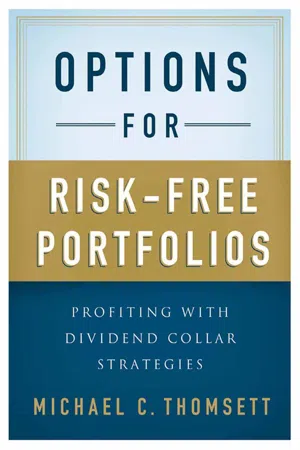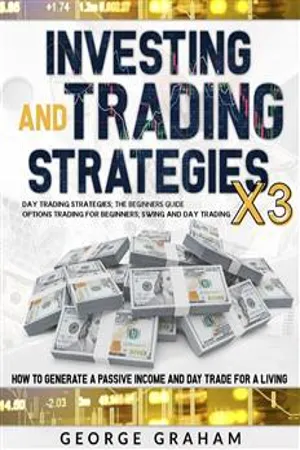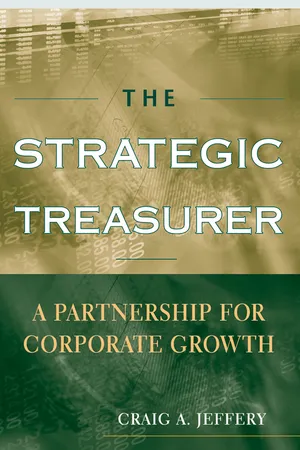Business
Options Risk Management
Options risk management involves strategies to mitigate potential losses associated with trading options. This includes techniques such as hedging, diversification, and setting stop-loss orders. By carefully managing the risks associated with options trading, businesses can protect their investments and minimize the impact of market fluctuations.
Written by Perlego with AI-assistance
Related key terms
4 Key excerpts on "Options Risk Management"
- eBook - ePub
Options for Risk-Free Portfolios
Profiting with Dividend Collar Strategies
- M. Thomsett(Author)
- 2015(Publication Date)
- Palgrave Macmillan(Publisher)
H A P T E R 2MANAGING AND REDUCING RISK WITH OPTIONS
To conquer without risk is to triumph without glory.Pierre Corneille, Le Cid , 1636MOST TRADERS ACKNOWLEDGE THAT OPTIONS MARKET RISKS ARE potentially high and come in many forms, unique to that market. However, the nature of risk is widely misunderstood as well. For the options market, several key risk discussions beyond the inherent market risk and short side risk potential need to be discussed. This lays the groundwork for a majority of options strategies and may also help traders to appreciate on a deeper level the range of risk issues they face.This range of topics includes the nature of market risk in general; stock short-selling risk (and a comparison between stock risks and alternative option strategies); differences between short calls and short puts; long option risks; spread and straddle risks; and less obvious risks of options trading.THE NATURE OF MARKET RISK IN GENERAL
Traders usually agree on the definition of simple market risk: The risk that portfolio values or components of the portfolio may lose value. For the purpose of discussion relating to options, the assumed market includes underlying securities consisting of not only stocks but also indices and exchange-traded funds (ETFs as well as related exchange-traded notes, or ETNs, and exchange-traded commodities, or ETCs).Market risk for the equity investment class on which options are written is also called equity risk, which factors in not only price but also the historical volatility, and when options are also in play as a combination strategy with equities, implied volatility is also a factor. For other nonequity markets, traders (within a portfolio as well as in consideration of derivative positioning) are concerned with interest rate risk, currency exchange risk, and commodity valuation risk. Options may apply to any and all of these, and in fact, are often used not as speculative devices but as hedging instruments, intended to reduce or eliminate common market risk as a feature of portfolio management. - eBook - ePub
Investing and trading strategies X3
Day Trading Strategies, Options Trading for Beginners, Swing and Day Trading
- George Graham(Author)
- 2023(Publication Date)
- Youcanprint(Publisher)
CHAPTER 7:Risk ManagementMoney and risk management doesn’t get nearly enough attention as it ought to, in my opinion. This is because it’s far sexier to talk about fancy strategies and show people how much money they can make. However, risk management is what underlines everything in trading and is what will make sure you keep your money in the long run. Understand this: It’s very easy to make money in the markets. That’s right. There’s no shortage of traders who make 100% gains per month. Keeping this money is a completely different matter, though. Those 100% gains traders usually wipeout after a month or two thanks to the improper risk and money management.In this chapter, I will show you basic money management techniques. By adopting these, as unglamorous as they might seem, you will put yourself ahead of virtually 90% of the traders out there. That’s traders. Not just beginners.What exactly is a risk? Well, to define it at its most basic level, it is simply the probability of you losing your money on a particular trade. Now, the keyword here is probability. There are a number of things that affect the probability of your trade being a win or a loss. So let’s look at these and see how you can reduce the risk associated with these individual items.There are risks to options trading that are worth mentioning, and here, we’ll discuss what they are, and why these risks should be mentioned when looking at options trading.The first is that options often expose sellers to more chances of loss. Unlike buyers or holders, the seller typically can incur a much greater loss than the contract price because when you write a call or put, you’re obligated to sell the shares at a price within a time frame. Even if it’s not favorable to do so, and there isn’t a cap on how high or how low the stock can go.There is also a limited time for this investment to bear out. This is a short-term investment. Options traders are always looking to capitalize on a price movement in the short term, so it must take place within days, weeks, or months from when the price movement happens, or when the payoff happens. This means you need to make the right assumptions, which means you are picking the right time to buy the option, and then deciding when you should exercise, sell, or just walk away before the option expires out. However, if you’re a long-term investor, you might have some benefits from this. - eBook - ePub
Credit Engineering for Bankers
A Practical Guide for Bank Lending
- Morton Glantz, Johnathan Mun(Authors)
- 2010(Publication Date)
- Academic Press(Publisher)
Chapter 12 Strategic Real Options Analysis: Managing Risk Through FlexibilityChapter Outline- What Are Real Options? 296
- The Real Options Solution in a Nutshell 297
- Issues to Consider 298
- Implementing Real Options Analysis 299
- Types of Real Options Strategies 300
- Execution Option Types 301
- Industry Leaders Embracing Real Options 301
- Automobile and Manufacturing Industry 301
- Computer Industry 302
- Airline Industry 302
- Oil and Gas Industry 302
- Telecommunications Industry 303
- Utilities Industry 303
- Real Estate Industry 303
- Pharmaceutical Research and Development Industry 303
- High-Tech and e-Business Industry 304
- Mergers and Acquisitions 304
- Real Options Example in Banking: Asset Liability Management 304
- Embedded Options in Financial Instruments 305
- Implementing Asset Liability Management 306
- Real Options Applications to Asset Liability Management 308
This chapter gives the reader a cursory look at and quick introduction to strategic real options analysis. It explains why only running simulations, forecasting, and optimization are not sufficient in a comprehensive risk management paradigm. Obviously, time-series forecasting and Monte Carlo simulation are used for identifying , predicting , and quantifying risks. The questions that should be asked are: So what? and What next? Quantifying and understanding risk is one thing, but turning this information into actionable intelligence is another. Real options analysis, when applied appropriately, allows you to value risk, creating strategies to mitigate risk and showing how to position yourself to take advantage - eBook - ePub
The Strategic Treasurer
A Partnership for Corporate Growth
- Craig A. Jeffery(Author)
- 2009(Publication Date)
- Wiley(Publisher)
risk tolerance levels or quantified thresholds at which hedge levels may be set and/or other action steps taken. These thresholds, individually and on aggregate, provide the basis for the firm’s critical risk management objectives. They can be defined by earnings, cash flow, or other financial measures.Risk Management ChoicesAn organization has three basic choices with respect to dealing with risk:2 accept it, avoid it, or manage it, the latter of which may entail altering and/or hedging the risk (see Exhibit 10.2 ).Accept
Depending on management’s tolerance for risk, it may choose to absorb the volatility through earnings, assuming that the upside may eventually outweigh the downside. That is, the risk exposure is within the stakeholders’ accepted risk appetite. Consider a wildcatter, or oil prospector, who does not hedge his oil price risk in the financial markets, but speculates on the price of oil going up. He accepts the inherent risk of prices going down. The reason he is in the business to begin with is that his appetite for risk is high.EXHIBIT 10.2 Risk Management ChoicesManagement’s risk preference notwithstanding, absorbing such risk may not always be feasible or even tolerable by stakeholders, given the potential volatility and its impact. Absorbing risk may put earnings on a potential roller coaster ride: the good ones may be exhilarating, while the bad ones can make a stomach turn!Avoid
If all other attempts to deal with risk fail, in that it cannot be brought within the entity’s risk appetite—via laying it off in the financial markets or by other means—then a change in business strategy to avoid the risk may be warranted. Such a choice may involve a decision to get out of the product line, the geographic market, or the business entirely. In the end, it is a cost-benefit, or risk-reward, decision.Manage
If the risk is unacceptable and the only way to avoid it is to get out of business, then the risk needs to be managed to bring the residual risk, the risk remaining once it has been managed or addressed, within the firm’s risk appetite. Managing risk does not necessarily mean one has to jump into hedging it with derivatives. As with most things in business, it comes down to a cost-benefit decision regarding the best method to manage the risk, which may include:1. A change in operating strategy to alter or transfer the risk 2. Hedging the risk utilizing offsetting financial or physical-delivery contracts
Index pages curate the most relevant extracts from our library of academic textbooks. They’ve been created using an in-house natural language model (NLM), each adding context and meaning to key research topics.



